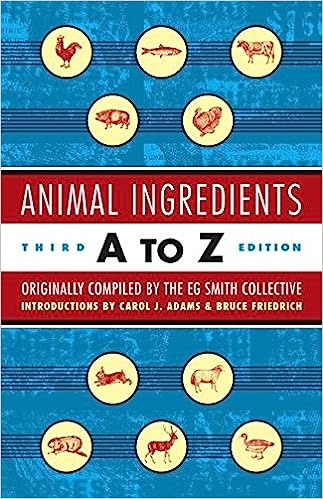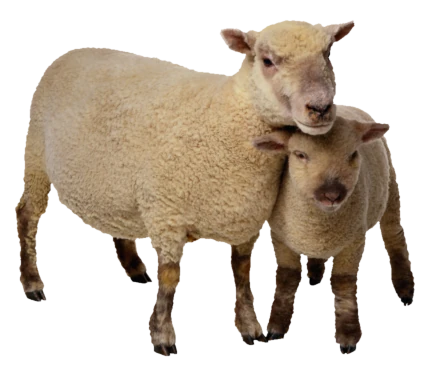Are you aware of the hidden animal ingredients in your food?
Vegans and vegetarians alike are often unaware that products we consume might contain animal ingredients and/or by-products of animals such as the ones contained in the following list.
Animal Ingredient List A-Z
Adrenaline.
Hormone from adrenal glands of hogs, cattle, and sheep. In medicine. Alternatives: synthetics.
Alanine.
(See Amino Acids.)
Albumen.
In eggs, milk, muscles, blood, and many vegetable tissues and fluids. In cosmetics, albumen is usually derived from egg whites and used as a coagulating agent. May cause allergic reaction. In cakes, cookies, candies, etc. Egg whites sometimes used in “clearing” wines. Derivative: Albumin.
Albumin.
(See Albumen.)
Alcloxa.
(See Allantoin.)
Aldioxa.
(See Allantoin.)
Aliphatic Alcohol.
(See Lanolin and Vitamin A.)
Allantoin.
Uric acid from cows, most mammals. Also in many plants (especially comfrey). In cosmetics (especially creams and lotions) and used in treatment of wounds and ulcers. Derivatives: Alcloxa, Aldioxa. Alternatives: extract of comfrey root, synthetics.
Alligator Skin.
(See Leather.)
Alpha-Hydroxy Acids.
Any one of several acids used as an exfoliant and in anti-wrinkle products. Lactic acid may be animal-derived (see Lactic Acid). Alternatives: glycolic acid, citric acid, and salicylic acid are plant- or fruit-derived.
Ambergris.
From whale intestines. Used as a fixative in making perfumes and as a flavoring in foods and beverages. Alternatives: synthetic or vegetable fixatives.
Amino Acids.
The building blocks of protein in all animals and plants. In cosmetics, vitamins, supplements, shampoos, etc. Alternatives: synthetics, plant sources.
Aminosuccinate Acid.
(See Aspartic Acid.)
Angora.
Hair from the Angora rabbit or goat. Used in clothing. Alternatives: synthetic fibers.
Animal Fats and Oils.
In foods, cosmetics, etc. Highly allergenic. Alternatives: olive oil, wheat germ oil, coconut oil, flaxseed oil, almond oil, safflower oil, etc.
Animal Hair.
In some blankets, mattresses, brushes, furniture, etc. Alternatives: vegetable and synthetic fibers.
Arachidonic Acid.
A liquid unsaturated fatty acid that is found in liver, brain, glands, and fat of animals and humans. Generally isolated from animal liver. Used in companion animal food for nutrition and in skin creams and lotions to soothe eczema and rashes. Alternatives: synthetics, aloe vera, tea tree oil, calendula ointment.
Arachidyl Proprionate.
A wax that can be from animal fat. Alternatives: peanut or vegetable oil.
Aspartic Acid. Aminosuccinate Acid.
Can be animal or plant source (e.g., molasses). Sometimes synthesized for commercial purposes.
Bee Pollen.
Microsporic grains in seed plants gathered by bees then collected from the legs of bees. Causes allergic reactions in some people. In nutritional supplements, shampoos, toothpastes, deodorants. Alternatives: synthetics, plant amino acids, pollen collected from plants.
Bee Products.
Produced by bees for their own use. Bees are selectively bred. Culled bees are killed. A cheap sugar is substituted for their stolen honey. Millions die as a result. Their legs are often torn off by pollen-collection trapdoors.
Beeswax. Honeycomb.
Wax obtained from melting honeycomb with boiling water, straining it, and cooling it. From virgin bees. Very cheap and widely used but harmful to the skin. In lipsticks and many other cosmetics (especially face creams, lotions, mascara, eye creams and shadows, face makeups, nail whiteners, lip balms, etc.). Derivatives: Cera Flava. Alternatives: paraffin, vegetable oils and fats. Ceresin, aka ceresine, aka earth wax. (Made from the mineral ozokerite. Replaces beeswax in cosmetics. Also used to wax paper, to make polishing cloths, in dentistry for taking wax impressions, and in candle-making.) Also, carnauba wax (from the Brazilian palm tree; used in many cosmetics, including lipstick; rarely causes allergic reactions). Candelilla wax (from candelilla plants; used in many cosmetics, including lipstick; also in the manufacture of rubber and phonograph records, in waterproofing and writing inks; no known toxicity). Japan wax (Vegetable wax. Japan tallow. Fat from the fruit of a tree grown in Japan and China.).
Benzoic Acid.
In almost all vertebrates and in berries. Used as a preservative in mouthwashes, deodorants, creams, aftershave lotions, etc. Alternatives: cranberries, gum benzoin (tincture) from the aromatic balsamic resin from trees grown in China, Sumatra, Thailand, and Cambodia.
Beta Carotene.(See Carotene.)
Biotin. Vitamin H. Vitamin B Factor.
In every living cell and in larger amounts in milk and yeast. Used as a texturizer in cosmetics, shampoos, and creams. Alternatives: plant sources.

